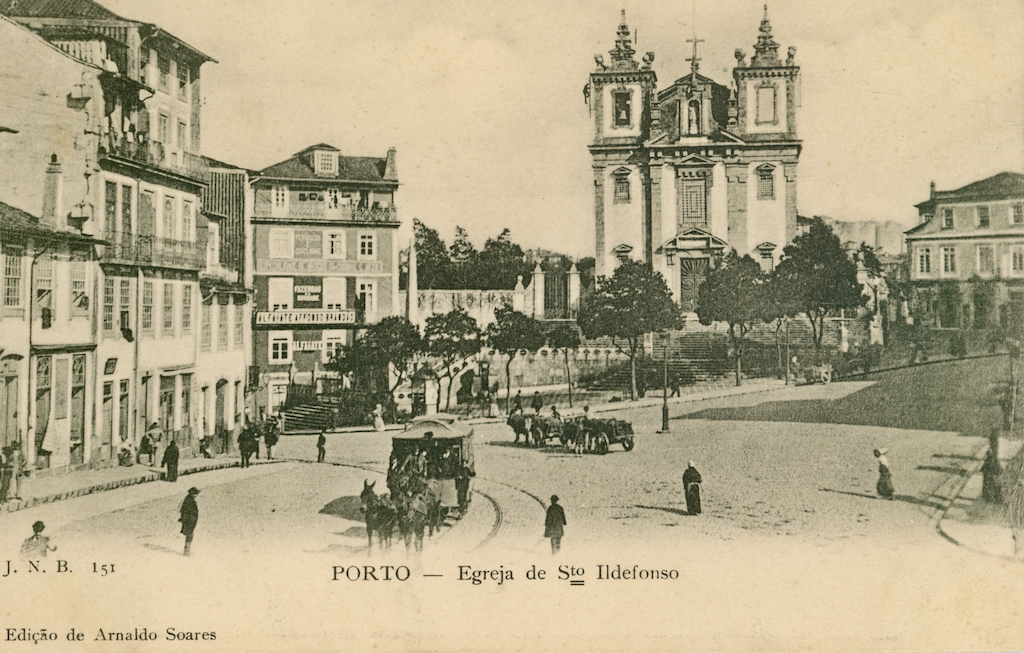
Porto, like many other cities, developed a horse tram system in the last decades of the 19th century, although instead of horses mainly mules were used to haul the vehicles. This page tells the history of these first trams of Porto. There is a separate page about the oldest tram vehicles.
The first horse trams
Already in 1832 in New York was the first attempt to explore an urban railway with the cars pulled by horses, or as we would say now a tramway. This first and very primitive line failed and was soon abandoned. Twenty years later another and now successful attempt was done, again in New York. This initiated the construction of more tramways in North America. In Europe only in Paris an experimental line was opened in 1853 followed by a more permanent line the year after. But even in Paris it took another twenty years before tramways started to develop into a public transport system covering the whole city. In the rest of Europe tram lines were opened in a number of cities during the 1860’s. Examples are Birkenhead (England) in 1860, Copenhagen in 1863, The Hague in 1864, Berlin in 1865 and Brussel in 1869. The real popularity of the horse trams however started in the 1870’s. The most expensive part of horse tram operations were the costs of the animals. Healthy strong animals were expensive to buy. The number of hours they could work on a day was limited as exhausting the animals would soon be punished by health problems. While in many countries mainly horses were used to pull the tramcars, in Portugal most trams were hauled by mules.
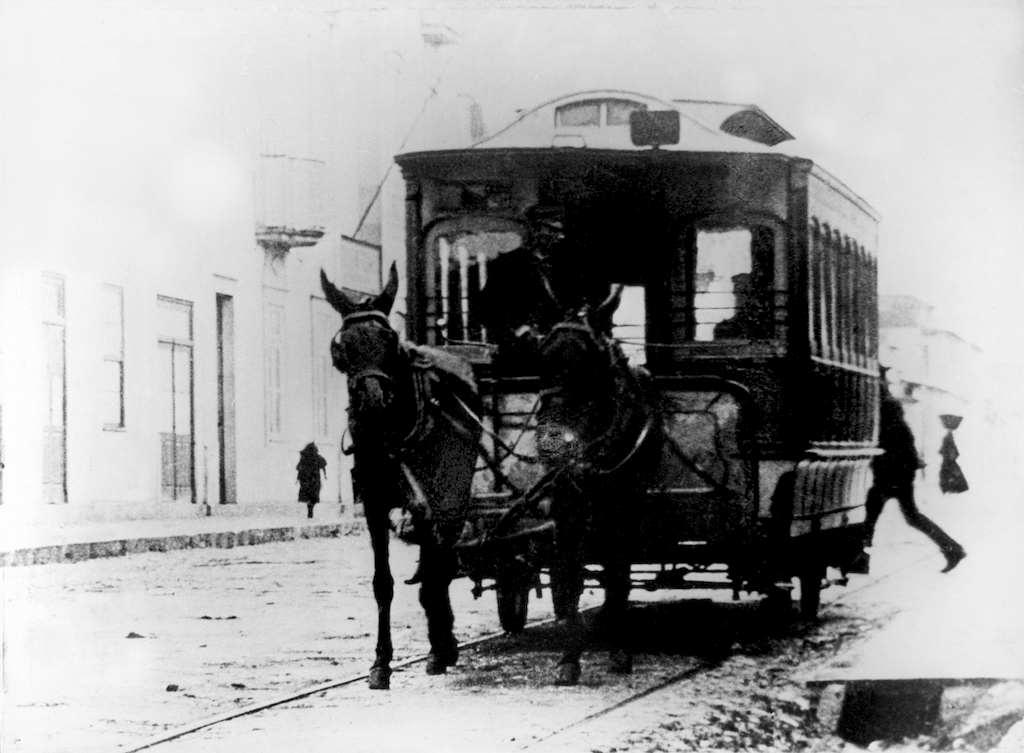
The city of Porto around 1870
Although the second largest city of the country, the built-up area of Porto was around 1870 still limited in size. Porto was important as the centre of the Northern part of the country and the major harbour for trade. The surroundings were still rural although along the river, mainly in Massarelos some industry developed during the 19th century. Since 1843 a suspension bridge, the Ponte Pensil, existed between the cities of Porto and Vila Nova de Gaia. This bridge had replaced a pontoon bridge. In 1859 the construction of the Alfândega complex was started to improve the harbour and custom facilities. The first part of this complex was inaugurated in 1869 and the buildings were completed about ten years later. The first railway near the city was opened in 1863, but was still limited from Devesas (VN de Gaia) in Southern direction. Using this railway, the Linha do Norte, it was since 1864 possible to go by train all the way from VN de Gaia to Lisboa. In 1875 the Campanhã station was opened together with the railway to Braga. The opening of the Ponte Maria Pia railway bridge in 1877 meant that Porto itself was now connected by rail with Lisboa.
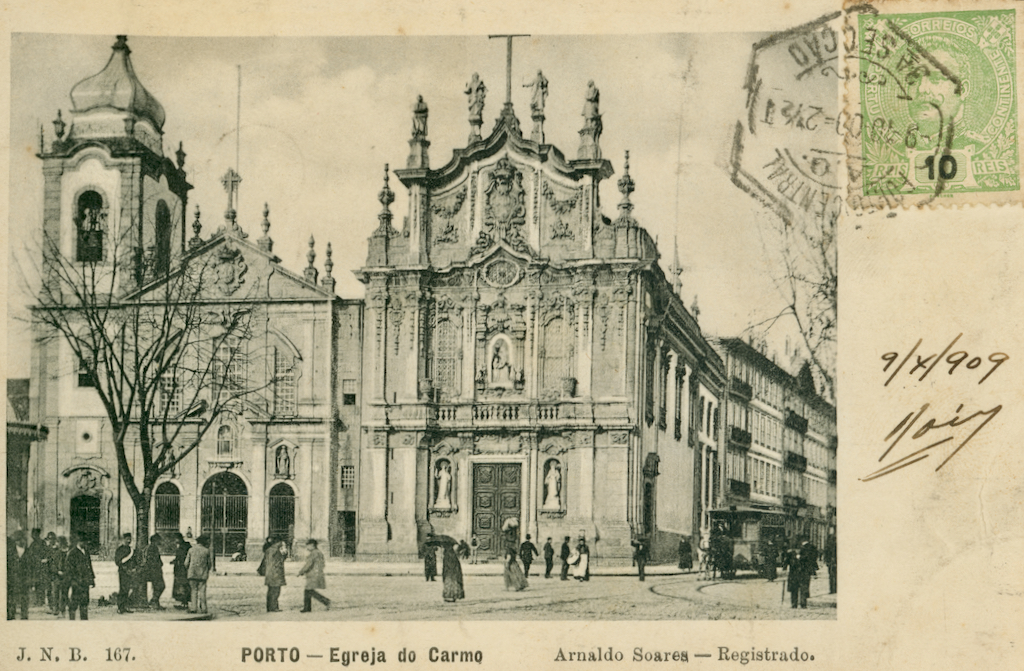
Porto means harbour and the river was until deep in the 20th century the scene of extensive harbour activities. With bad weather it was for ships difficult to enter the Douro river. Often it appeared to be too difficult and ended with shipwreck. Many captains choose to wait for better weather and shelter in the slightly more quiet waters near the rocks of Leixões close to Matosinhos, which until the 1870’s was a small fishing village. Around 1880 the government decided to construct here two moles together making on this location an artificial harbour. A narrow gauge railway was made for the transport of stones from the quarry of São Gens in Senhora da Hora to build the Leixões moles. After finishing the moles this railway line was used for freight and passengers traffic.
The construction of the harbour of Leixões in the 1880’s resulted in a fast growth of Matosinhos and with that the necessity of more transport options. The harbour also attracted new industry that generated even more traffic.
The Companhia Carril Americano (CCA)
In 1870 a concession was granted for a tramline from Porto via Foz do Douro to Matosinhos. The name of the company, Companhia Carril Americano do Porto á Foz e Matosinhos referred to the system (American) and the route. The construction of the line begun in July 1871 and a few months later also the first tramcars arrived from England. The depot was at “Ouro” on the location now known as Largo de Calém or Flúvial. It’s unknown when it was closed, but still in use at the beginning of the 20th century.
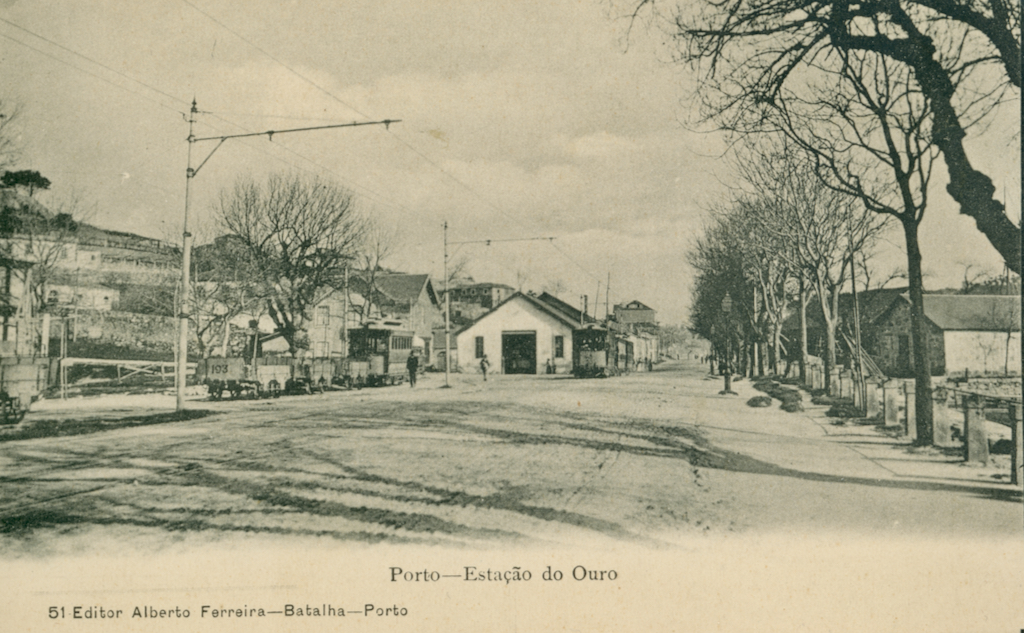
The company had to solve many technical problems, the major one with derailing trams during test rides. There was no experience yet in Portugal and getting advice from abroad wasn’t as easy as nowadays, but finally the problems were solved and the public service started on 9 March 1872 between Alfândega and Foz. The line was officially inaugurated on 15 May 1872. Three days later services started to Matosinhos where the terminus was in Rua Juncal de Cima (now Rua Brito Capelo) on the bank of the river Leça. On 24 May the line was complete in operation with the extension to it’s Porto terminus in Rua dos Inglezes (now Rua Infante Dom Henrique) close to the Igreja de São Nicolau. At the time Foz was a quite popular village. Matosinhos however was still a small village of fishermen. This was reflected in the first time-tables: every twenty minutes between Porto and Foz and every two hours up to Matosinhos, although the latter was soon increased to once an hour. In 1873 a branch line was opened between Cordoaria about where now is the south-eastern corner of the University building, and Massarelos via Rua da Restauração.
The Carril Americano also asked for concessions to extend its network into the city, but this was rejected. A competitor had entered the scene.
The Companhia Carris de Ferro do Porto (CCFP)
In 1872 a new company, the Companhia Carris de Ferro do Porto had asked concessions for an urban mule tram network and an own line to Foz do Douro. These concessions were granted in 1873. The CCFP built a depot at the Rotunda da Boavista, which was at that time still outside the built-up area of the city. This location became a public transport hub because on only about 100 m distance was the station of the narrow gauge railway to Póvoa de Varzim opened on 1 October 1875.
During the mule tram period a second, small depot was located in the city centre at Bolhão.
In August 1874 the CCFP opened its line from Porto to Foz. The original terminus in the city at Praça Carlos Alberto was two months later moved to Porta do Olival (close to the Torre dos Clerigos). The route went via Rua de Cedofeita – Boavista – Avenida da Boavista (at that time not yet reaching Castelo do Queijo) until Fonte da Moura and through the Campo das Erlvilhas to Foz where the terminus was at Cadouços. The first part of the route through Campo das Ervilhas became Rua Correia de Sá and a viaduct had to be made to cross Rua de Tânger (then still Rua de Serralves). The support wall at one side still exists but the viaduct is replaced by a longer and wider one.
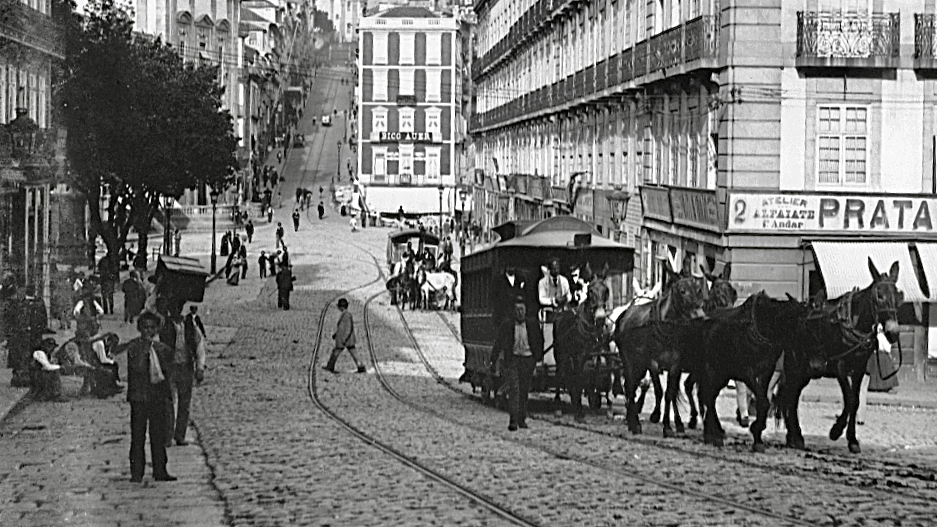
The first urban line was opened in February 1875 and went from Porta do Olival to Palácio. More important was the line opened on 13 June 1875 from Praça Carlos Alberto to Campanhã.
Also in 1875 Rua de Cedofeita was changed to be used by inbound trams only. The outbound trams went via Jardim do Carregal, Rua do Rosário and Rua Anibal Cunha. Between Jardim do Carregal and Rua do Rosário was a “tunnel” through buildings, which was still used by the electric trams during the first decades of the 20th century. In 1927, several years after the trams got the new route from Jardim do Carregal to Rosário, the tunnel was sold to the neighbours.
A few more tram routes were added and during the first years multiple changes were made with the framework of the services to figure out what suited best.
Since 1878 the CCFP also used steam locomotives on the route between Boavista and Foz (Cadouços). This line was in 1882 extended to Matosinhos. Since about 1887 only steam trams were used on the line Boavista – Foz Cadouços – Matosinhos. The CCFP mule trams were now limited to the urban lines.
CCFP network
By 1883 the framework of the CCFP was settled to three distinct lines:
– Matosinhos (Rua Juncal de Baixa, now Rua Roberto Ivens) – Foz Cadouços – Boavista (change from steam to mule traction v.v.) – Carmo – Praça D. Pedro – Bolhão – Batalha – Campanhã vv.
– Rua dos Ingleses (now Infante) – Praça D. Pedro – Bolhão – Cruz das Regateiras (now Hospital Conde Ferreira) vv.
– Boavista – Carmo – Porta do Olival – Palácio de Crystal – Carmo – Praça D. Pedro – Bolhão – Rua Duquesa da Bragança (now D. João IV) – Campo de Regeneração (now Praça da República) – Boavista (circular one way)
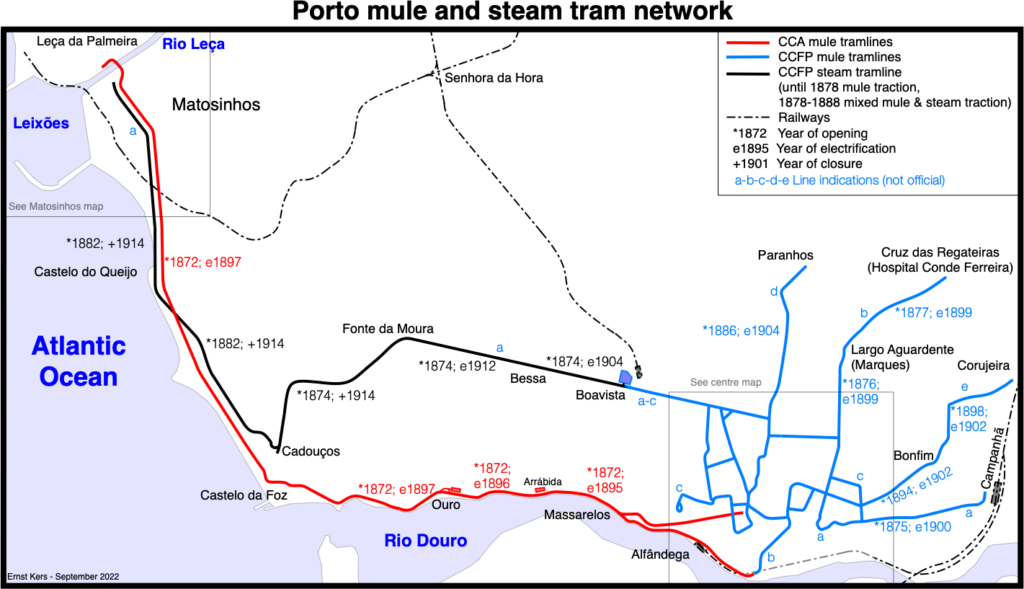
In 1886 the route Campo de Regeneração – Campo Lindo (Paranhos) was added with the outbound trams from Praça D.Pedro to Paranhos going via Bolhão and the inbound trams via Rua de Cedofeita. Since December 1892 the inbound trams of Paranhos used new tracks via Rua Martyres da Liberdade. In June 1894 the mule tramline to Bonfim was opened. This line was in May 1898 extended to the Mercado de Corujeira at a moment the electrification of the network had already started.
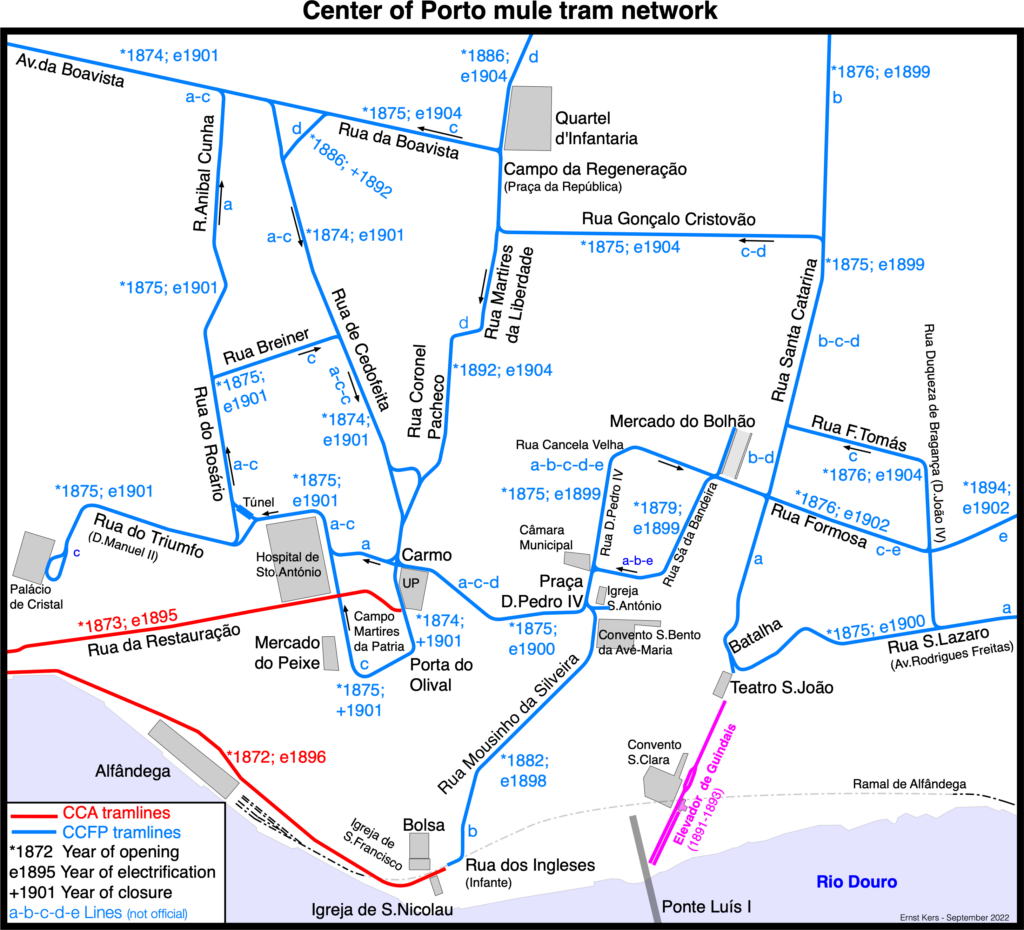
The bridges across the Leça
Residents of Leça da Palmeira had to use a boat or an ancient bridge located several hundreds of meters upstream the Leça river to get to the tram in Matosinhos, either the one of the CCA or the CCFP. The latter built in 1886 a wooden bridge for pedestrians between the location of the terminus and the opposite side of the river. The CCA now wanted its own bridge across the Leça too and ordered the Willebroeck company to build an iron bridge suited for trams. The Willebroeck company had engineers in Porto anyway for the construction of the Ponte Luís I. When finished the Carril Americano extended its line in 1887 over its own iron bridge to Rua do Arnado at the North end of the wooden bridge of the CCFP. This iron bridge was of very good quality: it didn’t only serve the mule trams, but later the electric trams included the heavy bogie trams and trailers. The iron bridge was only demolished in 1938 because of the construction of Doca no.1 of the Leixões harbour. The wooden bridge was already scrapped in 1922.
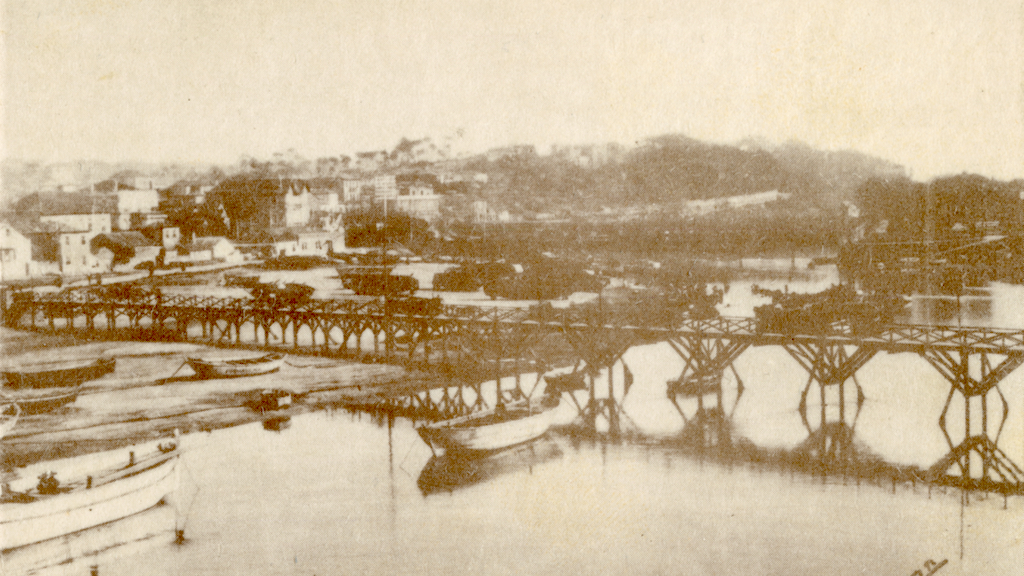
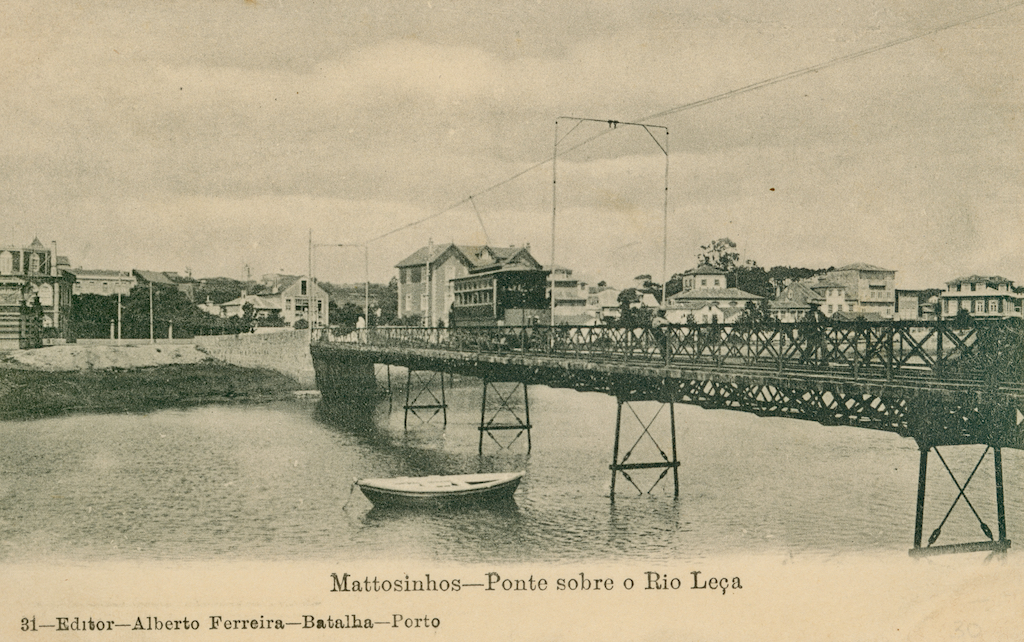
Mule freight trams
Both the Carril Americano and the CCFP already carried freight with mule trams. In 1886 the Carril Americano transported 10,839 ton material to be used for constructing the Porto de Leixões. With mule freight trams this must have been roughly 2500 trips to complete the whole transport. Perhaps included this transport were the parts of both Titan cranes that were ordered in 1886 from Fives-Lille and assembled the same year at Senhor do Padrão for the southern mole and Castelo da Leça for the northern mole. Likely this transport was between a short branch made in 1884 to the riverside near the Ouro depot and the Prado station of the narrow gauge railway that was also built in 1884 between the quarry of São Gens and the construction sites of the moles for the Leixões harbour. Both the Carril Americano and the CCFP had a siding at the Prado station.
The last freight transport with mule trams was of fish between the Boavista-PPF railway station and the market at Cordoaria. It was ended on 15 October 1904 because the CCFP didn’t have mules available anymore.
The CCFP takes over the CCA
Since the early 1870’s there were proposals to merge the CCFP and the Carril Americano into one company, but never an agreement was reached. By 1892 the financial situation of the CCA was unsustainable. The CCFP took the opportunity to buy the shares of its competitor and merged both early in 1893. At that moment the Carril Americano had 31 tramcars for passengers, six for freight and 202 mules. The CCFP itself had 62 tramcars for passengers, 18 for freight and luggage, 11 steam locomotives and 251 mules.
The end of the mule trams
Soon after take over of the CCA, the CCFP considered electrification of its network. As experiment in 1895 the old line of the CCA in Rua da Restauração was electrified. This was a great success and the electrification of the rest of the network already started in 1896 with the old main line of the CCA followed by the rest of the network until 1904. Only the steam tramline to Foz (Cadouços) and Matosinhos wasn’t electrified.
Sources
Guido de Monterey: O Porto, Origem, Evolução e Transportes, 2nd edition published in 1972.
Manuel Castro Pereira: Os Velhos Eléctricos do Porto, published in 1995.
John Price: The Tramways of Portugal, 1st edition 1964, 2nd edition 1972, 3rd edition 1883, 4th edition 1985 (3rd & 4th editions together with Brian King) Published by the LRTA.
Own research in the CCFP/STCP archives stored in the Arquivo Distrital do Porto, Rua das Taipas 90 – Porto.

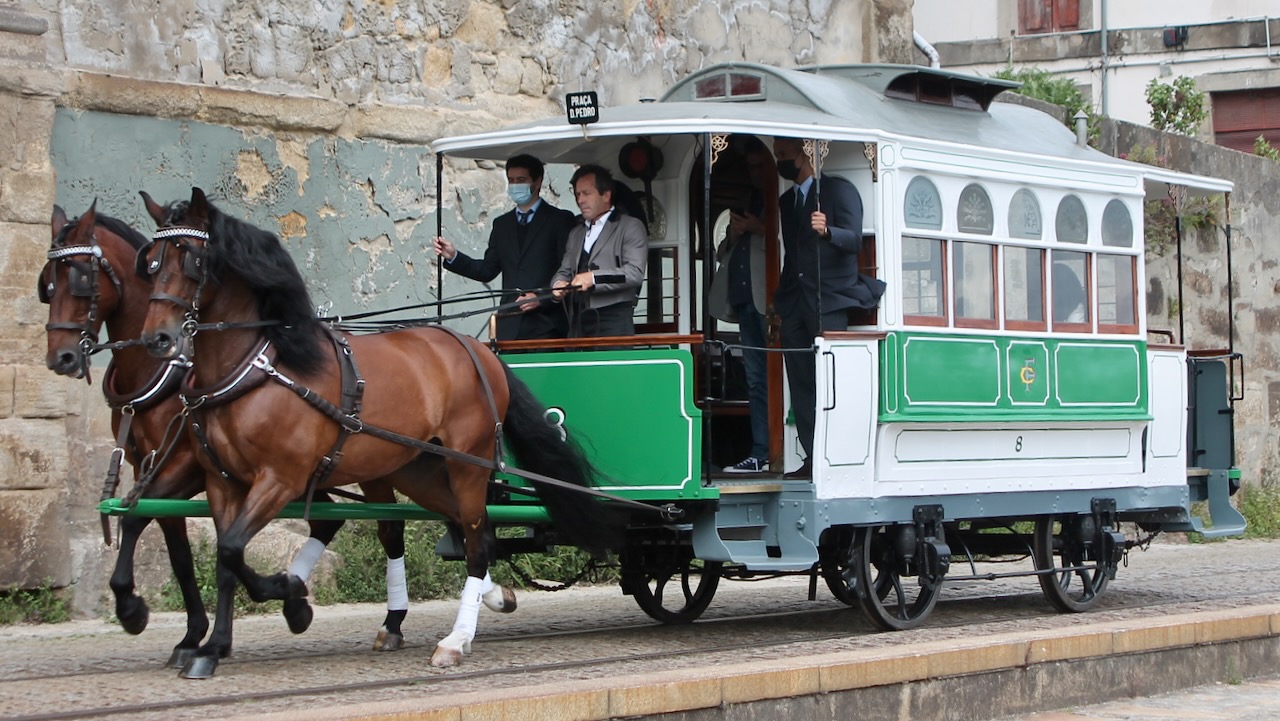
Leave a Reply